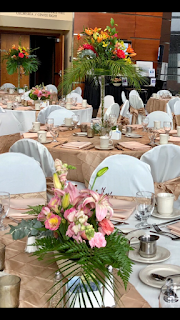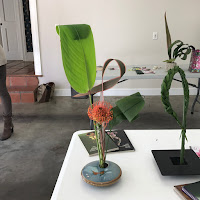This year our members were involved in creating table arrangements for two WV Garden Club meetings. The first was the Kanawha District meeting in Charleston in Fall, 2017. The arrangements below were made for the fall luncheon.
Tori (one of our talented arrangers) states: "For the arrangements, we used glass orbs, and plants and flowers from our yards and mini pumpkins from the Farmer’s Market. Each arrangement was different, but all had moss, ferns or branches and flowers in hot pink or purple. The success of the arrangement is leaving plenty of negative space so the individual plant material is visible. Less is more!"
In April, 2018, the WV Garden Club State Convention was held in Charleston. Again our members stepped up and created simple, yet lovely spring daffodil arrangements.
Tori again provides some details on the arrangements. "We made Kokedama arrangements; Japanese hanging
moss balls. It is recommended to use ferns or small trees, but we found some beautiful
tete-a-tete daffodils on sale so used them for a spring feeling. Then
the mud pie assembly line began. Using cactus soil mix, dampen enough so it
will form a ball. Place three to five daffodil bulbs in a handful of soil,
pressing so that it forms a ball around the bulbs as large as the container it
came in. Place the ball on a sheet of moistened moss, wrap it around the ball
of soil and wind twine around the ball, securing the moss. Tie in a double
knot. Through trial and error, we found it easiest to have one person holding
the ball while another wound the twine. Think of it like Twister with plants.
Using green or natural twine give the balls a different look, and heavy thread
can also be used to secure the moss. Our
arrangements were intended to be used for table decorations, then dismantled to
plant the daffodils. Ferns or other plants can be kept as indoor arrangements,
looping a piece of twine to hang the moss ball, and watering by submerging the
moss ball in a bowl of water."
Many of our members also belong to the WV Land Trust. This year, the Annual Special Places Gala and Fundraiser was held at the Clay Center in Charleston. A small group of talented flower arrangers from Kanawha GC spent the day of the event helping to create lovely arrangements for the tables. Jeanette Love, a volunteer extraordinaire, florist, and Events Coordinator for the WV Land Trust (as well as a full time professional with the Kanawha County School system) designed the low arrangements and was responsible for obtaining the flowers. Kanawha GC members designed the tall arrangements. Read Jeanette's post "A Wild and Wonderful Flower Story" on The FiftyFlowers site. It was a wonderful partnership and our members loved working with Jeannette and The Land Trust.
The photos above were provided by Debbie Eads & Anne Silbernagel
Photos above provided by Jeanette Love





































